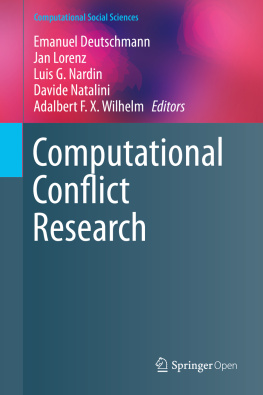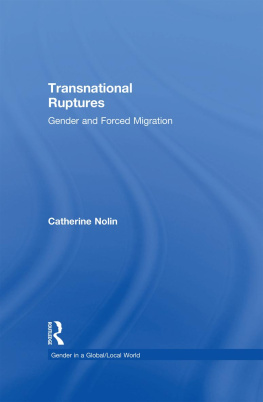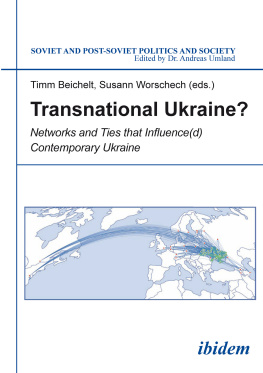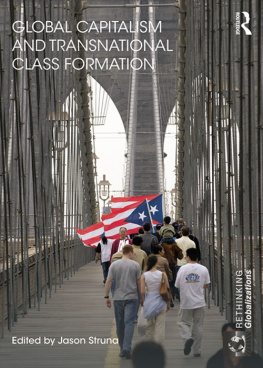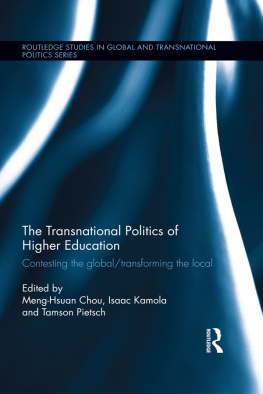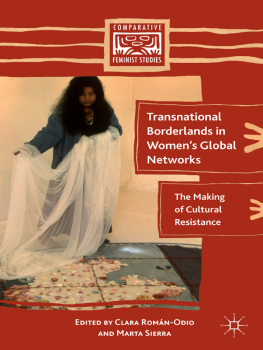MAPPING THE TRANSNATIONAL WORLD
Princeton Studies in Global and Comparative Sociology
Andreas Wimmer,Series Editor
Mapping the Transnational World: How We Move and Communicate across Borders, and Why It Matters, Emanuel Deutschmann
Agents of Reform: Child Labor and the Origins of the Welfare State, Elisabeth Anderson
Persuasive Peers: Social Communication and Voting in Latin America, Andy Baker, Barry Ames, and Lcio Renn
Give and Take: Developmental Foreign Aid and the Pharmaceutical Industry in East Africa, Nitsan Chorev
Citizenship 2.0: Dual Nationality as a Global Asset, Yossi Harpaz
Nation Building: Why Some Countries Come Together While Others Fall Apart, Andreas Wimmer
The Paradox of Vulnerability: States, Nationalism, and the Financial Crisis, John L. Campbell and John A. Hall
Mapping the Transnational World
How We Move and Communicate across Borders, and Why It Matters
Emanuel Deutschmann
PRINCETON UNIVERSITY PRESS
PRINCETON AND OXFORD
Copyright 2021 by Princeton University Press
Princeton University Press is committed to the protection of copyright and the intellectual property our authors entrust to us. Copyright promotes the progress and integrity of knowledge. Thank you for supporting free speech and the global exchange of ideas by purchasing an authorized edition of this book. If you wish to reproduce or distribute any part of it in any form, please obtain permission.
Requests for permission to reproduce material from this work should be sent to
Published by Princeton University Press
41 William Street, Princeton, New Jersey 08540
6 Oxford Street, Woodstock, Oxfordshire OX20 1TR
press.princeton.edu
All Rights Reserved
Library of Congress Control Number: 2021944063
ISBN 9780691226491
ISBN (pbk.) 9780691226484
ISBN (e-book) 9780691226507
Version 1.0
British Library Cataloging-in-Publication Data is available
Editorial: Meagan Levinson and Jacqueline Delaney
Production Editorial: Nathan Carr
Jacket/Cover Design: Pamela L. Schnitter
Production: Erin Suydam
Publicity: Kate Hensley and Kathryn Stevens
Copyeditor: Patricia Fogarty
Jacket/Cover Credit: Network of estimated trips between countries worldwide based on data from the Global Mobilities Project. Image created by Emanuel Deutschmann, 2020.
International life is merely social life of a higher kind, and one which sociology needs to know.
MILE DURKHEIM AND MARCEL MAUSS (1971 [1913]: 813)
The apparently simple acknowledgement of a meaningful relationship between society and space hides a fundamental complexity.
MANUEL CASTELLS (2010: 441)
SUMMARY OF CONTENTS
- xiii
- xv
ACKNOWLEDGMENTS
A study that aims at mapping the transnational world at the global scale is by necessity a collaborative endeavor. This book evolved over a period of almost nine years and was written in parts in Bremen, Darmstadt, Magdeburg, Princeton, Florence, and Gttingen, backed by the institutional support of the Bremen International Graduate School of Social Sciences (a joint institute of Jacobs University and University of Bremen), the Chair of Macrosociology at Otto-von-Guericke University Magdeburg, Princeton Universitys Global Systemic Risk research community, the Global Mobilities Project at the European University Institutes Migration Policy Centre, and the University of Gttingen. Jan Delhey, my mentor in Bremen and later in Magdeburg, provided excellent guidance and support while simultaneously giving me the freedom to develop my own ideas and the time to realize thema rare combination of odds for which I am deeply grateful. Steffen Mau and Jrgen Gerhards also provided fantastic counsel and feedback whenever I needed it. I was very fortunate to be able to meet and discuss my work with them on a regular basis as a member of the German Research Foundations (DFG) Research Unit Horizontal Europeanization. I am also indebted to the other members of the research group who gave important advice during our biannual meetings. Many formal and informal discussions with colleagues and friends in various places contributed to this book. I am also grateful to Miguel Centeno, who gave me the opportunity to visit the Global Systemic Risk research community and the Sociology Department at Princeton University and to present my work to a distinguished interdisciplinary audience. His Mapping Globalization project was an inspiration to this study, which also relies data-wise on the Princeton International Networks Archive that he and his team created. Ettore Recchi and Andrew Geddes later gave me the chance to continue to work on the book as a member of the Global Mobilities Project at the EUI in Florence, and the same holds for Cline Teney at the University of Gttingen. I am grateful for their support and countless fruitful conversations. Thanks to Cline Teneys generous financial assistance, this book contains a color insert. Moreover, I am indebted to the many other scholars who commented on my work at conferences, workshops, and colloquia in Aarhus, Amsterdam, Bremen, Berlin, Bilbao, Cologne, Dublin, Essex, Florence, Magdeburg, Montreal, Oldenburg, Prague, Princeton, Trier, Turin, and Vienna. Lea Kliem and Martin Gneist helped in preparing some of the data used in this book. Michael Biggs, Franziska Deutsch, Mandy Boehnke, Klaus Boehnke, Nora Waitkus, Arndt Wonka, Johannes Huinink, Martin Ruhs, Jacinta Garca Mora, and Kate Layton-Matthews provided excellent support, advice, and feedback in various forms. Adrian Favell and one anonymous reader, who reviewed the manuscript for Princeton University Press, gave incredibly helpful comments, and I am deeply grateful for their dedicated commitment to improving this book. Needless to say, all remaining errors are my own. At PUP, I would also like to thank Meagan Levinson, Jacqueline Delaney, Theresa Liu, Nathan Carr, and Patricia Fogarty, for their invaluable guidance in the revision and publication process, and Andreas Wimmer, for including this book in the Princeton Studies in Global and Comparative Sociology series.
The empirical parts of this book are based on data gathered by a vast number of people, organizations, and states from all over the world. It was made available at no charge for research by a range of institutions, including, inter alia, the United Nations High Commissioner for Refugees (UNHCR), the United Nations Educational, Scientific and Cultural Organization (UNESCO), the Centre dtudes Prospectives et dInformations Internationales (CEPII), the International Telecommunication Union (ITU), Princetons International Networks Archive (INA), and the World Tourism Organization (UNWTO). Without these organizations and the hardworking individuals behind them, this book would not have been possible. Furthermore, this project profited from research stays, methods training, and conferences in Princeton, Essex, and Prague that were financially supported by the German Academic Exchange Service (DAAD), the DFG Research Unit Horizontal Europeanization, and the European Sociological Association (ESA), respectively. Parts of were published in earlier form in


